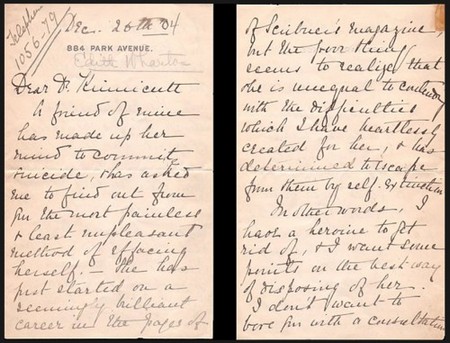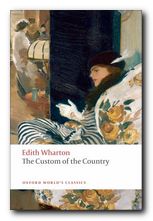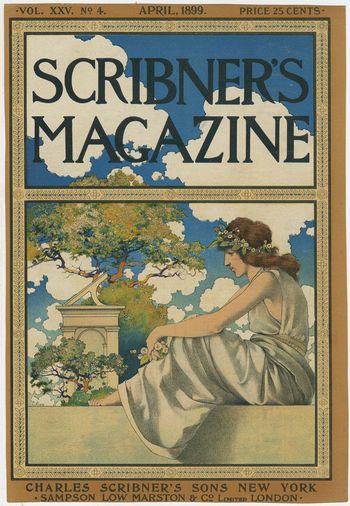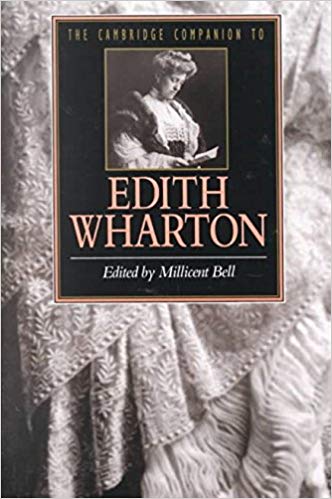tutorial, commentary, study resources, plot, and web links
Kerfol first appeared in the Scribner’s Magazine number 59 for March 1916. The story was included in the collection Xingu and Other Stories published in New York by Charles Scribner’s Sons in 1916. It is one of the many ghost stories Edith Wharton wrote and was also included in the collection Ghosts published in 1937.
cover design by Parish Maxfield
Kerfol – critical commentary
The principal feature of interest in this story is the manner in which the narrative is unfolded. The un-named narrator is encouraged to buy the old Brittany chateau, and visits a perfectly credible if slightly romantic old building with a moat, high walls, a garden and a tower. The only strange element is the absence of human habitation and the presence of so many unusually quiet dogs.
This introductory episode is then contrasted with and expanded upon in the reconstruction of the murder trial which the narrator makes from old court records. These events reveal the passionate drama of the imprisoned beauty (Anne) her cruel husband (Yves) and her would-be lover (Hervé). who is a relative and namesake of the friend of the narrator in the fictional ‘present’.
The ghosts of the story are not those of former human beings, but dogs seeking vengeance on the man who has strangled them to terrorise his wife. This is a reasonable variation on the Gothic horror story which has lingered from its heyday in the eighteenth and nineteenth centuries to its fashionable revival at the begriming of the twentieth.
Edith Wharton wrote a number of ghost stories, and like her friend Henry James who did the same, she tried to create inventive variations on the plots and themes of this genre. Kerfol has a number of standard elements – the old deserted chateau, a wicked ‘King’, his beautiful young wife, and the would-be swain (all figures out of medieval romance) but to make the ghosts a pack of avenging dogs is something of a novelty, even if the outcome so far as Anne is concerned provides the tale with a conventionally grim ending and tragic victim.
Kerfol – study resources
![]() The Works of Edith Wharton – Amazon UK
The Works of Edith Wharton – Amazon UK
![]() The Works of Edith Wharton – Amazon US
The Works of Edith Wharton – Amazon US
![]() The New York Stories – NYRB – Amazon UK
The New York Stories – NYRB – Amazon UK
![]() The New York Stories – NYRB – Amazon US
The New York Stories – NYRB – Amazon US
![]() Edith Wharton Collected Stories – Norton Critical – Amazon UK
Edith Wharton Collected Stories – Norton Critical – Amazon UK
![]() Edith Wharton Collected Stories – Norton Critical – Amazon US
Edith Wharton Collected Stories – Norton Critical – Amazon US
![]() The Descent of Man and Other Stories – Project Gutenberg
The Descent of Man and Other Stories – Project Gutenberg
![]() A Historical Guide to Edith Wharton – Amazon UK
A Historical Guide to Edith Wharton – Amazon UK
![]() The Cambridge Introduction to Edith Wharton – Amazon UK
The Cambridge Introduction to Edith Wharton – Amazon UK
Kerfol – plot summary
Part I. At the suggestion of his friend Lanvirain, an un-named narrator goes to visit an old semi-fortified mansion in Brittany. He is impressed by its age and the sense of history it exudes. No guardian or owners appear, but he is met by a pack of assorted dogs which are mysteriously quiet. When he returns to his friend’s house that night, Mrs Lanvirain tells him that the dogs are the ‘ghosts of Kerfol’.
Part II. Next day Lanvirain lends him an old book containing the history of Kerfol, which the narrator then transcribes to reconstruct the historic events that constitute the remainder of the story.
Part III. Some time during the seventeenth century, the lord of Kerfol, widower Yves de Cornault takes a new young wife Anne. The marriage is childless but successful. He is very strict with her, but showers her with valuables. After one trip away on business, he brings her a little brown dog.
When de Cornault is suddenly found mutilated and dead in the mansion, suspicion falls on his young wife, because she is discovered in the same place, covered in blood.
There is a trial, throughout which she maintains her innocence. But she is prepared to admit that on the night of the murder she had an assignation with Hervé de Lanvirain. She also claims that her husband had strangled her pet dog.
She met Lanrivain whilst on a religious visit, and he offered her his sympathy and support. When he leaves for a foreign journey, she gives him the dog’s collar as a memento. Her husband returns to the mansion and strangles the dog with the same collar. She obtains another dog, but he strangles that one too. The same thing happens to further dogs.
She then receives a secret message from Lanvirain and that night goes to meet him. When her husband suddenly appears at the top of the stairs, she claims he was attacked and mauled to death by a pack of dogs.
At the trial she is not convicted, but put in the care of her husband’s family. They shut her up in the dungeon at Kerfol where she dies many years later, having gone mad.
Kerfol – Principal characters
| I | an un-named narrator |
| Hervé de Lanvirain | his friend |
| Yves de Cornault | despotic lord of Kerfol |
| Anne de Cornault | his pretty and much younger wife |
| Hervé de Lanvirain | her would-be lover |

Edith Wharton’s writing
Further reading
Louis Auchincloss, Edith Wharton: A Woman of her Time, New York: Viking, 1971,
Elizabeth Ammons, Edith Wharton’s Argument with America, Georgia: University of Georgia Press, 1982, pp.222. ISBN: 0820305138
Janet Beer, Edith Wharton (Writers & Their Work), New York: Northcote House, 2001, pp.99, ISBN: 0746308981
Millicent Bell (ed), The Cambridge Companion to Edith Wharton, Cambridge: Cambridge University Press, 1995, pp.232, ISBN: 0521485134
Alfred Bendixen and Annette Zilversmit (eds), Edith Wharton: New Critical Essays, New York: Garland, 1992, pp.329, ISBN: 0824078489
Eleanor Dwight, Edith Wharton: An Extraordinary Life, New York: Harry N. Abrams, 1994, ISBN: 0810927950
Gloria C. Erlich, The Sexual Education of Edith Wharton, California: University of California Press, 1992, pp.223, ISBN: 0520075838
Susan Goodman, Edith Wharton’s Women: Friends and Rivals, UPNE, 1990, pp.220, ISBN: 0874515246
Irving Howe, (ed), Edith Wharton: A collection of Critical Essays, London: University of North Carolina Press, 1986,
Jennie A. Kassanoff, Edith Wharton and the Politics of Race, Cambridge: Cambridge University Press, 2004, pp.240, ISBN: 0521830893
Hermione Lee, Edith Wharton, London: Vintage, new edition 2008, pp.864, ISBN: 0099763516
R.W.B. Lewis, Edith Wharton: A Biography, New York: Harper and Rowe, 1975, pp.592, ISBN: 0880640200
James W. Tuttleton (ed), Edith Wharton: The Contemporary Reviews, Cambridge: Cambridge University Press, 1992, pp.586, ISBN: 0521383196
Candace Waid, Edith Wharton’s Letters from the Underworld, London: University of North Carolina Press, 1991,
Sarah Bird Wright, Edith Wharton A to Z: The Essential Reference to Her Life and Work, Fact on File, 1998, pp.352, ISBN: 0816034818
Cynthia Griffin Wolff, A Feast of Words: The Triumph of Edith Wharton, New York: Perseus Books, second edition 1994, pp.512, ISBN: 0201409186
Other works by Edith Wharton
 The Custom of the Country (1913) is Edith Wharton’s satiric anatomy of American society in the first decade of the twentieth century. It follows the career of Undine Spragg, recently arrived in New York from the midwest and determined to conquer high society. Glamorous, selfish, mercenary and manipulative, her principal assets are her striking beauty, her tenacity, and her father’s money. With her sights set on an advantageous marriage, Undine pursues her schemes in a world of shifting values, where triumph is swiftly followed by disillusion. This is a study of modern ambition and materialism written a hundred years before its time.
The Custom of the Country (1913) is Edith Wharton’s satiric anatomy of American society in the first decade of the twentieth century. It follows the career of Undine Spragg, recently arrived in New York from the midwest and determined to conquer high society. Glamorous, selfish, mercenary and manipulative, her principal assets are her striking beauty, her tenacity, and her father’s money. With her sights set on an advantageous marriage, Undine pursues her schemes in a world of shifting values, where triumph is swiftly followed by disillusion. This is a study of modern ambition and materialism written a hundred years before its time.
![]() Buy the book from Amazon UK
Buy the book from Amazon UK
![]() Buy the book from Amazon US
Buy the book from Amazon US
 The House of Mirth (1905) is the story of Lily Bart, who is beautiful, poor, and still unmarried at twenty-nine. In her search for a husband with money and position she betrays her own heart and sows the seeds of the tragedy that finally overwhelms her. The book is a disturbing analysis of the stifling limitations imposed upon women of Wharton’s generation. In telling the story of Lily Bart, who must marry to survive, Wharton recasts the age-old themes of family, marriage, and money in ways that transform the traditional novel of manners into an arresting modern document of cultural anthropology.
The House of Mirth (1905) is the story of Lily Bart, who is beautiful, poor, and still unmarried at twenty-nine. In her search for a husband with money and position she betrays her own heart and sows the seeds of the tragedy that finally overwhelms her. The book is a disturbing analysis of the stifling limitations imposed upon women of Wharton’s generation. In telling the story of Lily Bart, who must marry to survive, Wharton recasts the age-old themes of family, marriage, and money in ways that transform the traditional novel of manners into an arresting modern document of cultural anthropology.
![]() Buy the book from Amazon UK
Buy the book from Amazon UK
![]() Buy the book from Amazon US
Buy the book from Amazon US
Edith Wharton – web links
Edith Wharton at Mantex
Biographical notes, study guides to the major novels, tutorials on the shorter fiction, bibliographies, critiques of the shorter fiction, and web links.
The Short Stories of Edith Wharton
This is an old-fashioned but excellently detailed site listing the publication details of all Edith Wharton’s eighty-six short stories – with links to digital versions available free on line.
Edith Wharton at Gutenberg
Free eTexts of the major novels and collections of stories in a variety of digital formats – also includes travel writing and interior design.
Edith Wharton at Wikipedia
Full details of novels, stories, and travel writing, adaptations for television and the cinema, plus web links to related sites.
The Edith Wharton Society
Old but comprehensive collection of free eTexts of the major novels, stories, and travel writing, linking archives at University of Virginia and Washington State University.
The Mount: Edith Wharton’s Home
Aggressively commercial site devoted to exploiting The Mount – the house and estate designed by Edith Wharton. Plan your wedding reception here.
Edith Wharton at Fantastic Fiction
A compilation which purports to be a complete bibliography, arranged as novels, collections, non-fiction, anthologies, short stories, letters, and commentaries – but is largely links to book-selling sites, which however contain some hidden gems.
Edith Wharton’s manuscripts
Archive of Wharton holdings at the Beinecke Rare Book and Manuscript Library
© Roy Johnson 2014
Edith Wharton – short stories
More on Edith Wharton
More on short stories

